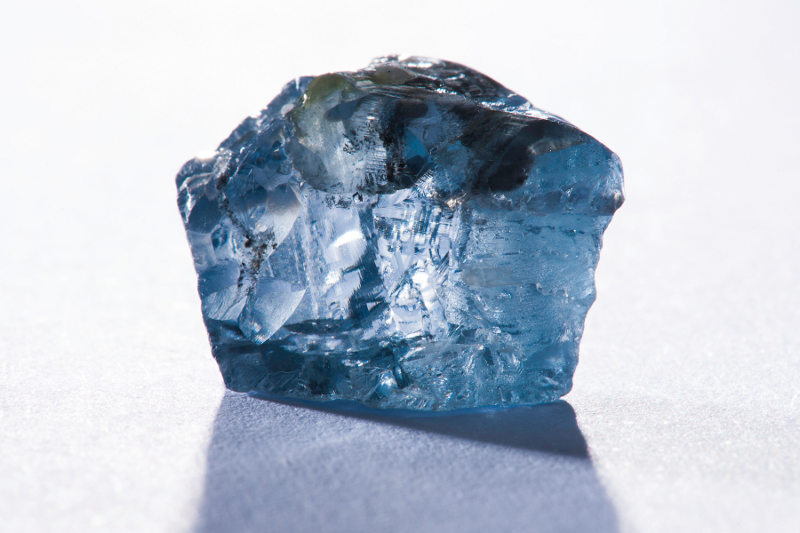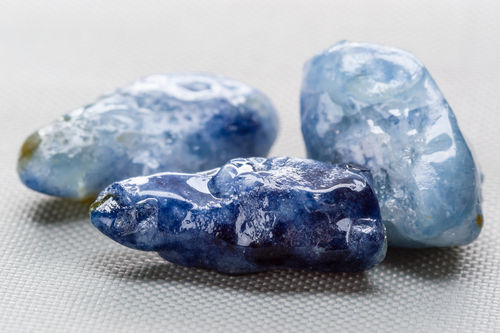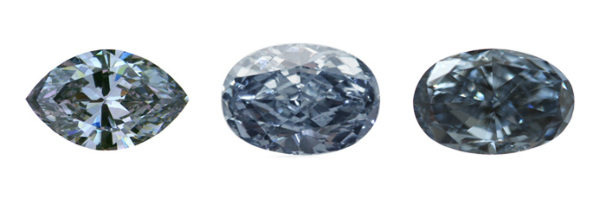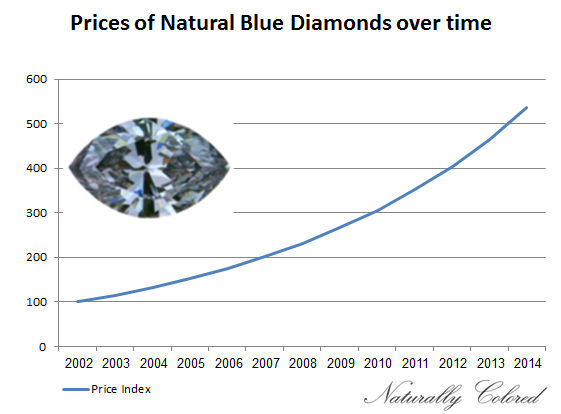Blue Diamond vs. Sapphire?
- Home /
- Diamond Buying Guides /
- Blue Diamond vs. Sapphire
For centuries, blue diamonds and sapphires have captivated consumers looking to make a dazzling and colorful investment. Both stones boast awe-inspiring hues, impressive durability and substantial worth. Additionally, the value of both diamonds and sapphires is determined by the 4 C's: color, cut, clarity and carat weight. They also come in many different sizes and shapes, meaning no matter your budget or style preferences, there's likely a perfect fit for you.


Petra Diamonds famous 29.6ct Rough Blue Diamond vs Uncut Blue Sapphire
While these gems have several things in common, there are also a number of notable differences between them.
Search Blue Diamonds Search Blue Sapphires
Composition
One of the most significant differences between blue diamonds and sapphires is their chemical makeups. A blue diamond is composed entirely of pure carbon. Small amounts of the element boron get trapped in the crystal structure, giving these stones their unique hue. PriceScope noted that hydrogen is typically the cause of a greyish or more violet blue hue in diamonds, while greenish blue diamonds usually contain nitrogen impurities.
On the other hand, blue sapphires are made of corundum, or aluminum oxide. Traces of titanium that are responsible for their color.
Origins
Another key distinguishing factor is where these stones are found. Blue diamonds are found in very few locations across the globe. The majority of them are discovered in Rio Tinto's Argyle Mine in Australia and Petra Diamonds' Cullinan mine in South Africa. Lesser amounts of them these colored diamonds have been unearthed in the Golconda mine of India.
Meanwhile, sapphires (also known as the birthstone of September) are mined in many areas around the world. According to the International Colored Gemstones Association, these include India, Burma, Ceylon, Thailand, Vietnam, Australia, Brazil and Africa. Sri Lanka is where the oldest sapphires are found. In recent years, experts have found early evidence of two large-scale deposits of large sapphire crystals in Tanzania.
The oldest sapphire finds are in Ceylon, or Sri Lanka as it is known today. These are known as Ceylon Sapphires and are considered the best Sapphires mined today.
Color
Both blue diamonds and sapphires can range immensely in the shade and intensity of their color. For blue diamonds, the grading scale may be faint blue, very light blue, light blue, fancy light blue, fancy blue, fancy intense blue, fancy deep blue and fancy vivid blue. As the content of boron increases, so does the intensity of the blue color.
 Shades of Blue Diamonds – Fancy, Intense and Deep Blue
Shades of Blue Diamonds – Fancy, Intense and Deep Blue
Diamond Education
Sapphires can also display a variety of shades, from a pale sky blue to a rich, royal blue. The higher the concentration of titanium in the sapphire, the more saturated the hue. Unlike blue diamonds, sapphires that contain secondary colors like green or purple cannot be classified as blue sapphires, and are considered to be "fancy" colors, according to The Natural Sapphire Company. It's common to see the term "cornflower blue" used to describe a sapphire with that particular hue, but it's important to note that this is not an official grading classification, but more of a marketing buzz phrase.
Rarity and Price
A major reason why some consumers may opt for blue sapphires over blue diamonds is that they are often much more affordable. This is because sapphires are easier to come by. While these stones are more heavily mined than diamonds, the return on high-quality sapphires is significantly less than the production and availability of many other gemstones, making them a sound investment.
Still, natural blue diamonds are exceptionally rare - far more so than sapphires - and are becoming increasingly difficult to find. This is why blue diamonds have been achieving record prices at auction in recent years. In fact, according to the Natural Color Diamonds Association, the prices of blue diamonds have increased in average of 12%-17% per year over the last decade.
 The Change in prices of Natural Blue Diamonds over the last decade
The Change in prices of Natural Blue Diamonds over the last decadebased on data from the NCDIA
Durability
Diamonds are the hardest mineral known to man, receiving a 10 on the Mohs Scale. As such, Brilliant Earth explained that diamonds cannot be as easily scratched or abraded. Also, for this reason, it's more common for sapphires to need re-polishing than blue diamonds. Diamonds are not completely chip-resistant, however.
While they may not match blue diamonds in durability, sapphires are a nine on the Mohs scale. That means that the only natural gemstone that is capable of scratching a sapphire is a diamond. Sapphires are able to withstand surface scratching and abrasions very well, and therefore, are an optimal choice for everyday wear.
Fire
Perhaps the most important aspects to discuss in differentiating blue diamonds from sapphires are fire and brilliance. As diamonds refract more light than sapphires, they boast a more dazzling appearance - that sparkle that instantly attracts and mesmerizes the viewer. Even when they are somewhat dirty on the surface, they will still glitter and gleam in a remarkable way. This, in addition to their rarity, is in great part a reason why they are so valuable and desirable.
Sapphires, of course, still sparkle nicely - but the fire can't quite compare due to inferior refraction of light. When sapphires get dirty, they may look slightly clouded and their brilliance can become hampered.
All in all, both blue diamonds and sapphires are not only smart but also stunning choices for a variety of jewelry. However, blue diamonds have the advantage in regard to rarity, durability and fire.
